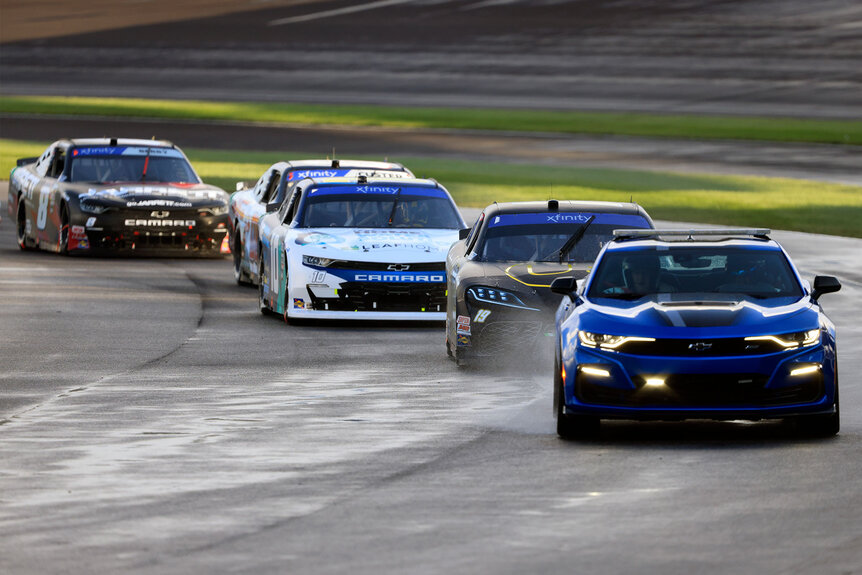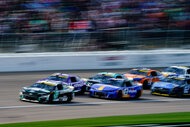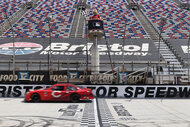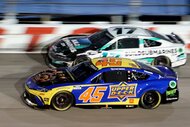Create a free profile to get unlimited access to exclusive show news, updates, and more!
What's the Difference Between the NASCAR Cup Series and Xfinity Series Cars?
When it comes to the technology and parts used in the cars for each series, small adjustments can have major impacts.

Though the Cup Series is the crown jewel of NASCAR, the Xfinity Series is a gem of a stock car racing circuit that should not be missed. Some might be quick to judge the Xfinity Series as the “minor league” of stock car racing, but there’s nothing minor about it.
As a proving ground for future generations that go on to compete in the world’s most talented stock car racing circuit, it’s no secret that NASCAR’s second tier exudes a thrilling level of competition as several racers from the elite Cup Series like Tyler Reddick and Kyle Larson regularly enter Xfinity events. The result is a win-win as they get to hone their skills, and Xfinity racers get to square off against some of the best-of-the-best.
RELATED: Legendary NASCAR Crew Chief Tommy Baldwin Jr. Reveals Cancer Battle
With the periodic addition of racers from the most elite circuit to the Xfinity Series, here's how the vehicles they're driving for each series stack up against each other.
Size and Weight
One of the most obvious differences between the cars in the two series is their size disparity. Each of the league’s three car manufacturers — Chevrolet, Ford and Toyota — produce a separate vehicle for each series. The Chevy Camaro is reserved for the Xfinity Series while the Camaro Zl1 competes in the Cup Series. Ford, likewise, produces two different types of Mustangs, and Toyota utilizes the Camry for Cup events while entering the Supra for Xfinity Series races. From the jump, the two models are not the same size.
To the naked eye, the Cup cars’ additional five inches in its wheelbase might not seem like a massive difference but, by extending it from the Xfinity Series’ length of 105 inches to 110 inches, the ripple effect results in a cascade of differences, from the aerodynamic packages to the safety modifications. The difference in measurements doesn’t stop there. In the Xfinity Series, cars are approximately 11 inches longer, one inch taller and four inches narrower than Cup Series competition vehicles.
RELATED: Chase Elliott’s Cup Series Season on the Brink After He Literally Ran Out of Gas
Due to its larger overall size, the Cup Series Next Gen car weighs in, with a driver, at 3,500 pounds compared to the vehicle used in the Xfinity Series, which clocks in around 100 pounds less, according to Motor Racing Sports. With more weight and the benefit of more efficiently harnessing the power of its engine and sleeker body, the Cup Series Next Gen car has a need for the speed the Xfinity Series rides just fail to match.
Do the cars in NASCAR's Cup Series and Xfinity Series have the same size wheels?
Another crucial difference between the two NASCAR series lies in the wheels. The Xfinity Series cars employ 15-inch steel wheels while those featured in the Cup Series cars measure 18 inches and are crafted from aluminum. Additionally, the Cup Series Next Gen car that made its debut last year also features a single lug nut in the center of the wheel for a more seamless extraction than that of the five lugs used in Xfinity Series cars.
How does the chassis differ in Cup Series and Xfinity Series cars?
You can’t see it, but the Cup Series car is hiding another significant difference than its counterpart in the Xfinity Series: its chassis. Created by Dallara to be not only more advanced but also safer, the tube-framed chassis of the Next Gen car used in the Cup Series is designed with impacts in mind. Because it’s composited from three pieces bolted together, if one portion is significantly damaged in a wreck, a Cup Series team can unfasten it from the car and reattach a new piece.
From a conceptual standpoint, though safety was a major selling point with the Next Gen car, drivers last year spoke out after a litany of high-intensity impacts mounted up, all pointing to the need for additional safety precautions to address their concerns. In the league engineers’ overhaul of the vehicle, metal bars were perforated with holes while some bars were removed entirely. The intended result means that, on significant impacts, the cars collapse and more efficiently diffuse the brunt of the kinetic energy away from the cockpit, thus further mitigating a driver’s potential exposure to life-threatening forces.
RELATED: Bubba Wallace Takes Aim at Boss Denny Hamlin in Fun Social Media Exchange
In theory, by not having to trash significant or sometimes entire car frames like teams were forced to do in earlier league years, they also can dramatically cut costs and reduce their operating budget.
What's the difference in cars' exhaust systems in the Cup Series and Xfinity Series?
The exhaust systems of the vehicles in the Cup Series and the Xfinity Series differ dramatically, according to Flow Racers. Cars in the Xfinity Series are designed to have their exhaust pipes positioned on the right side of the vehicle whereas the exhaust systems in the Cup Series cars are located on both sides of the vehicle. Furthermore, the Xfinity Series cars still require carburetors which NASCAR eliminated in all Cup Series competitions, starting in 2012.
For all their unique differences, while Cup cars contain a five-speed sequential manual transmission, and Xfinity cars still use four-speed transmissions, their engines remain relatively similar. Engines in both series offer 358 cubic inches of displacements, and they are both V8, aspirated pushrod engines. This produces a comparable horsepower in each series — 670 for Cup Series cars at most tracks, whereas Xfinity vehicles can top out at 700.
















